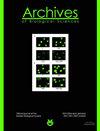Correlation between echocardiographic findings and biochemical markers in term newborns with moderate to severe perinatal asphyxia
IF 0.8
4区 生物学
Q4 BIOLOGY
引用次数: 0
Abstract
Perinatal asphyxia (PA) is a condition characterized by a gas exchange disorder due to a lack of blood flow or gas exchange, with potential multiorgan dysfunction. Our study aimed to determine the correlation between biochemical markers and echocardiography findings in a group of asphyxiated newborns. The prospective cohort study included 120 neonates (52/120 with PA) treated at a tertial referral pediatric center, from 2012 to 2014. A moderate-strong positive correlation was recorded between the transtricuspid pressure gradient (TRPG) and serum lactate, and between TRPG and NT-proBNP in the PA group (P<0.001) on the 1st day of life. A moderate positive correlation was found between NT-proBNP, lactate and troponins on one side, and TRPG on the other in the PA group after the 2nd measurement. Multinomial regression analysis showed that the lactate level was an independent factor for survival on the 1st (odds ratio (OR) 41.3, 95% confidence interval (CI) 2.14-797.1) and 3rd (OR 136.4, 95% CI 2.27-8206.7) days. Our research confirmed a significant correlation between echocardiographic and biochemical parameters of the myocardial lesion and cardiac function. Due to their complementarity, the use of the biochemical and echocardiographic parameters may be conditioned by their availability.中重度围产期窒息足月新生儿超声心动图表现与生化指标的相关性
围产期窒息(PA)是一种以缺乏血液流动或气体交换导致的气体交换障碍为特征的疾病,并伴有潜在的多器官功能障碍。我们的研究旨在确定一组窒息新生儿的生化指标和超声心动图结果之间的相关性。这项前瞻性队列研究包括2012年至2014年在一家儿科转诊中心接受治疗的120名新生儿(52/120名PA患者)。PA组患者在出生第1天的心内压梯度(TRPG)与血清乳酸水平、NT-proBNP水平呈中强正相关(P<0.001)。第2次测量PA组NT-proBNP、乳酸、肌钙蛋白与TRPG呈中度正相关。多项回归分析显示,乳酸水平是第1天(优势比(OR) 41.3, 95%可信区间(CI) 2.14-797.1)和第3天(OR 136.4, 95% CI 2.27-8206.7)生存的独立因素。我们的研究证实了超声心动图和心肌病变生化参数与心功能之间的显著相关性。由于它们的互补性,生化和超声心动图参数的使用可能受到它们的可用性的限制。
本文章由计算机程序翻译,如有差异,请以英文原文为准。
求助全文
约1分钟内获得全文
求助全文
来源期刊
CiteScore
1.40
自引率
0.00%
发文量
25
审稿时长
3-8 weeks
期刊介绍:
The Archives of Biological Sciences is a multidisciplinary journal that covers original research in a wide range of subjects in life science, including biology, ecology, human biology and biomedical research.
The Archives of Biological Sciences features articles in genetics, botany and zoology (including higher and lower terrestrial and aquatic plants and animals, prokaryote biology, algology, mycology, entomology, etc.); biological systematics; evolution; biochemistry, molecular and cell biology, including all aspects of normal cell functioning, from embryonic to differentiated tissues and in different pathological states; physiology, including chronobiology, thermal biology, cryobiology; radiobiology; neurobiology; immunology, including human immunology; human biology, including the biological basis of specific human pathologies and disease management.

 求助内容:
求助内容: 应助结果提醒方式:
应助结果提醒方式:


